Six Portland mayoral candidates sounded off on transportation issues Monday night in the first (and possibly the only) event of the 2016 election season to focus exclusively on transportation.
Hosted by the Portland chapter of Young Professionals in Transportation, the event drew candidates Deborah Harris, Jules Bailey, Jessie Sponberg, Sean Davis, David Schor and Bim Ditson.
Ted Wheeler, by far the best-funded candidate and one of the clear frontrunners, didn’t make it. Sarah Iannarone, who with Wheeler and Bailey is one of the three candidates who have raised enough money for a dedicated campaign staff, initially RSVP’d but didn’t turn up for the forum either.
Iannarone wrote online Tuesday that “as a single, working mom and candidate, sometimes I have scheduling conflicts beyond my control.” Monday night on Twitter, Wheeler offered to field questions digitally. (See below.)
But we also came to the debate wanting to hear from some important players in this election that BikePortland hasn’t yet interviewed many of: voters.
So after the event, we talked to seven attendees to get a few thoughts the debate, the candidates, and the race so far.
Kristin Sweeney
Sweeney said she lives in North Portland, near Lombard and Mississippi, and commutes by bike across the Columbia River to East Vancouver three days a week. The proposal from several candidates — Schor, Sponberg and Ditson — that bike traffic should be carried by a “parallel network” away from main streets caught her attention.
“The whole parallel network idea is interesting to me,” she said. “It would be nice if it happened. But it doesn’t seem like it’s going to happen.”
She wants candidates to be proposing ideas that would more immediately improve the city — including helping change the way people think about bikes.
“Just today I had a sort of heated discussion with someone who left the door open in the bike lane,” she said. “Honestly, the thing that makes me feel unsafe is that I assume people are angry at me.”
Patrick Rafferty
Rafferty said he’d been following BikePortland’s interviews and that it was too bad Iannarone had been absent.
“Sarah seems like my girl, I think,” he said. “She’s thinking really big, I think — bigger than most. .. Portland is great. But the way it got great is by thinking big.”
Rafferty said he was a little surprised that Iannarone was promising to move toward a car-free area downtown within 10 years rather than within her first four-year term.
“She’s not thinking unreasonably big,” he concluded.
Rafferty aded that he also thinks Wheeler, Shor and Bailey are “fine” and that Ditson seemed to be running the campaign that he wished Bailey were running.
“They’re all fine except Sponberg,” Rafferty said.
Lale Santelices
Santelices, a program staffer for the Community Cycling Center (where she is, among other things, a coordinator for the family bike-fun club Andando en Bicicletas en Cully) said that as a noncitizen immigrant from Chile, she’s not a voter. But she’s very active in local issues and engaged in the race.
She was talking with Ditson when I approached, and said she had liked what he had to say. She also expressed warmth toward Harris, noting that she is a woman of color on a stage dominated by white men. Still, she said she felt let down by all the candidates.
“I am not very impressed,” she said. “Everyone was trying to let me know that they’re bikers too. Fuck that! I don’t want you to be a biker if you haven’t biked. … You don’t need to be a biker to have empathy for biking.”
“If anybody had said that, I would have been like, ‘yes!'”
Laura Krull
“I thought Jules did a good job and I thought assistant attorney general [Schor] did a good job,” Krull said.
Charlie Tso
“I felt there was a little bit of dodging the question, I wish they would have been a little more straightforward,” said Tso. “I think Jules was knowledgeable on a lot of this but I don’t know if he came across as someone who was willing to stand up.”
Tso said he wished Iannarone had attended.
“I really wish Sarah had been here,” he said. “She’s the one I’ll vote for. She’s the one who I think understands the fundamental issues.”
Ted Buehler
Buehler is one of the co-chairs of activist group BikeLoudPDX. He said he’s fully undecided in the mayoral race, and Monday’s debate hadn’t changed that.
“When somebody hits the mayoral seat, they have a certain amount of political capital that they can burn on specific projects,” he said. “And since I think transportation is our most pressing concern, bicycles in particular, I want to hear them saying that they’re going to push for bicyclists.”
On the other hand, Buehler said, “I think the bicycle constituency is strongest when it’s seen as a swing voter bloc.” Buehler said that when former Mayor Sam Adams was caught lying about his sexual relationship with a young aide, he knew that biking supporters were in his base and he had to burn all his political capital supporting other groups.
“So I suppose that I’m happy that more of them aren’t really pushing bicycles too much,” Buehler said.
He added that he realized this was a contradictory set of opinions.
Jodie Beechem
Beechem thoughtfully disclosed up front that she’s Ditson’s girlfriend and plans to vote for him. But she was happy to share further thoughts.
“I thought everybody did well,” she said. “It seemed like everybody was on the same page.”
Besides Ditson, she said, she “really likes” Davis and Schor.
Advertisement
So what was said at the debate? For those of us who’ve been following their past statements, the candidates didn’t break a lot of new ground. That’s actually a good sign for transportation policy: even without transportation-focused debates, every candidate on the stage has received enough of these questions before to know the language of the issues fairly well and have a well-developed set of positions.
.@juleskbailey's Vision Zero position: need $$ to spend on sidewalks, protected bike lanes, diverters. Plugs @fixpdxstreets gas tax plan.
— BikePortland (@BikePortland) April 5, 2016
.@ozone2016's Vision Zero plan: keep bikes off big streets, set 10 mph speed limit on side streets.
Hmm.
— BikePortland (@BikePortland) April 5, 2016
“Ozone” is Sponberg’s Twitter handle.
.@davidschor and @bimditson add to the calls for "parallel routes" for bikes off major streets as a Vision Zero policy.
— BikePortland (@BikePortland) April 5, 2016
.@juleskbailey also calls it "crazy" that Oregon constitution bans gas taxes from being spent on public transit.
— BikePortland (@BikePortland) April 5, 2016
.@davidschor says one of the best things Portland can do for biking is boost "secure, covered bike parking"
— BikePortland (@BikePortland) April 5, 2016
To me (though, OK, I’m biased) the most striking thing about the debate was that every single candidate present signed on to some aspect of the so-called Shoupian view of auto parking: that if people have to pay a market rate for the cost of the space their cars require, the whole transportation system will work better.
Next Q: How can we use parking policy to get city down to 43% driving by 2035?
— BikePortland (@BikePortland) April 5, 2016
Deborah Harris tells the secret to getting more convenient parking: higher parking prices! Spoiler: this is true.
— BikePortland (@BikePortland) April 5, 2016
(Harris mentioned the statistic, first cited by parking economist Donald Shoup, that something like 30 percent of congested downtown traffic consists of people circling the block for parking spaces, at least in some cities.)
.@ozone2016 on parking policy: "no more publicly subsidized parking. meters everywhere. Eff your car."
— BikePortland (@BikePortland) April 5, 2016
.@originalseanD: "any money we spend to build more parking structures is money wasted. it's money we spend on the past."
— BikePortland (@BikePortland) April 5, 2016
.@davidschor: parking downtown must be expensive enough to give people an incentive to take transit.
— BikePortland (@BikePortland) April 5, 2016
The number of mayoral candidates who just said exactly what transpo reformers would want them to say about parking was really remarkable.
— BikePortland (@BikePortland) April 5, 2016
The next question was also about transportation economics: decongestion pricing. Already in use in Singapore, Stockholm and London, the idea is that charging people to drive on busy streets during the busiest hours helps the system run more efficiently by shifting nonessential auto trips to other modes or times. The usual proposal is to use that toll money to improve public transit and active transportation, which makes it easier for people to avoid the decongestion charge by using a mode that doesn’t increase congestion for everyone else.
Next question: Do you support pricing our roadways to reduce congestion? @yptportland not avoiding the big questions here.
— BikePortland (@BikePortland) April 5, 2016
I didn’t get Bailey’s response on Twitter, but the former professional transportation economist endorsed this concept Monday, as he had in our interview last month.
.@bimditson says "the only way" to "bridge the massive gap in infrastructure funding that we have" is to "toll the roads."
— BikePortland (@BikePortland) April 5, 2016
If I got that right, @ozone2016 wants a "progressive gas tax" that charges people more by income.
— BikePortland (@BikePortland) April 5, 2016
.@davidschor and @BimDitson support congestion pricing with an exception or lower rate if you're poor.
— BikePortland (@BikePortland) April 5, 2016
.@sarahforpdx and @tedwheeler are getting out of a lot of tough questions by missing this event. Next Q: dedicated bus lane on Powell?
— BikePortland (@BikePortland) April 5, 2016
.@juleskbailey says he's for BRT but doesn't answer the question of whether he'd back a bus lane on Powell. Gets boos from a few folks.
— BikePortland (@BikePortland) April 5, 2016
.@davidschor If we spend millions on BRT and bus times don't improve, that gets in way of more BRT.
— BikePortland (@BikePortland) April 5, 2016
As I said above, Iannarone (who did get to Rontom’s about 30 minutes after the debate wrapped up and talked with people there) and Wheeler both made efforts to share thoughts on Twitter. On Tuesday Iannarone retweeted this Twitter user’s answer to the parking question:
Simultaneous demand based pricing, decoupling of parking from housing, transit infrastructure, + active transportation @BikePortland
— Claudia Preciado (@Claudia_Pres) April 5, 2016
And added:
What can I add @BikePortland? For-profit district parking near transit? 'In lieu of' fees? @DonaldShoup on speedial? https://t.co/Oe2ls5zrDU
— Sarah Iannarone (@sarahforpdx) April 5, 2016
On bus rapid transit:
1/2 BRT is essentially useless w/o dedicated ROW between city center and 82nd. https://t.co/3aJ74AYIAL
— Sarah Iannarone (@sarahforpdx) April 5, 2016
2/2 Priority w Powell BRT should be community concerns E of 82nd: walking distance 2 stops, frequency & displacement https://t.co/3aJ74AYIAL
— Sarah Iannarone (@sarahforpdx) April 5, 2016
And on another question, about specific plans to improve walking in East Portland:
1/2 Prioritize $ to high crash intersections, reallocate car space on sts like NE 148th to safe walkways #VisionZero https://t.co/nmHrsipQMn
— Sarah Iannarone (@sarahforpdx) April 5, 2016
2/2 Partner with @Oregon_DOT to pilot boulevards on arterials (like @movela is doing), w focus on community dev. https://t.co/nmHrsipQMn
— Sarah Iannarone (@sarahforpdx) April 5, 2016
We haven’t heard from Wheeler yet, but we’ll update this post if we do.
It’s safe to say that in almost any city in the country, a slate of mayoral candidates saying everything above would be a transportation reformer’s hopeless dream.
Not a single candidate spoke up to argue that people who drive everywhere would be harmed by these positions; the only objections to higher parking prices and congestion costs were that they would disproportionately burden poor people. Not a single candidate promised to locate a secret bottomless pit of developer profits that could build neighborhoods out of parking shortages. Not a single candidate claimed that it’s not worth investing in buses because people prefer their cars. Not a single candidate dismissed the notion that Portland can greatly increase its share of trips on bicycles.
It’s troubling that two major candidates didn’t show. But it’s also true that candidates have extremely difficult schedules, sometimes getting invitations to two such forums on wildly different subjects in a day. Iannarone’s policy positions aren’t dramatically different from any that were shared Monday night. Neither are Wheeler’s, though he’s never been immersed in transportation issues the way Bailey and Iannarone have.
As several of the people we interviewed at the top of this story pointed out, there’s room for these candidates to improve. But the happy truth about Portland is that most people who are engaged in public life, including every one of these candidates, agree on the most fundamental questions before the city.
The Portland consensus gives us an opportunity that few cities have. And there’s no telling how long it’s going to last. That’s why it’s going to be so important, in the next few years, for us to choose a mayor who won’t squander it.
— Michael Andersen, (503) 333-7824 – michael@bikeportland.org
BikePortland can’t survive without subscribers. It’s just $10 per month and you can sign up in a few minutes.



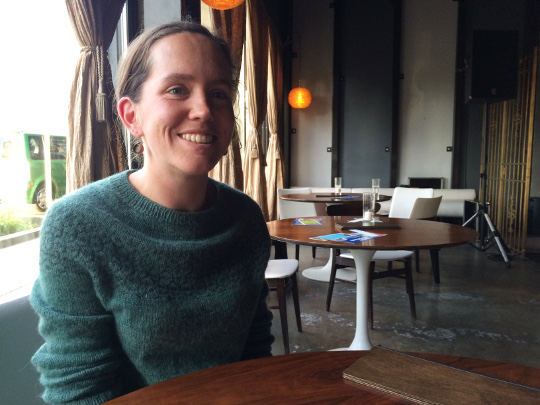
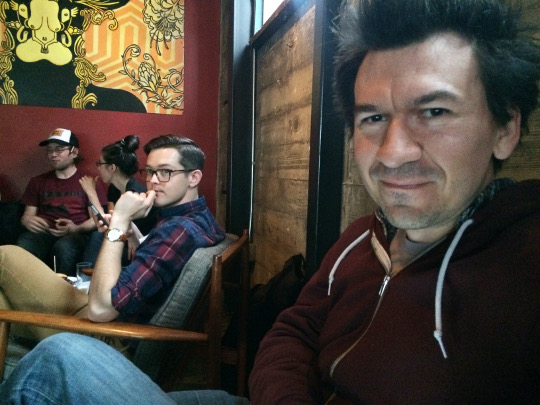
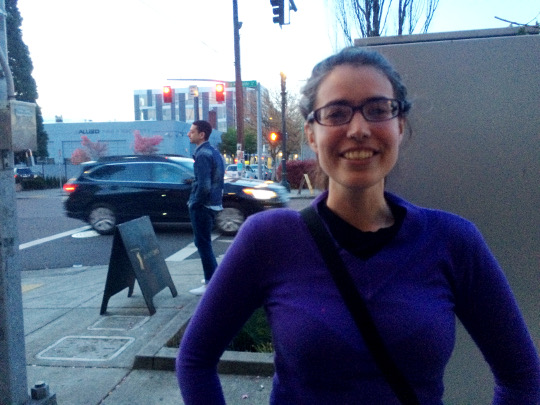
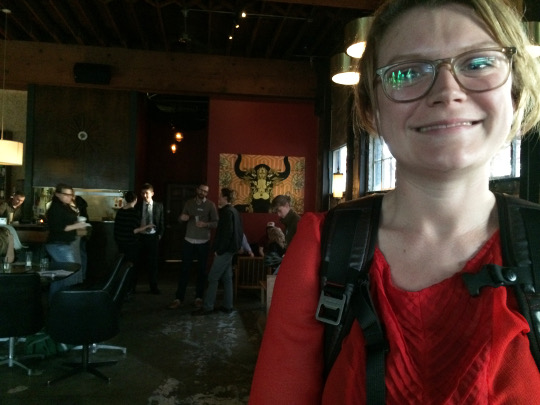
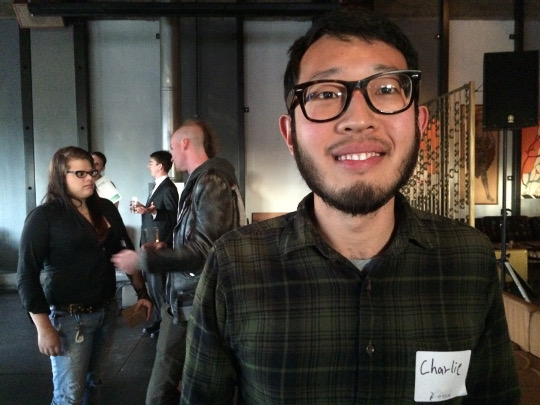
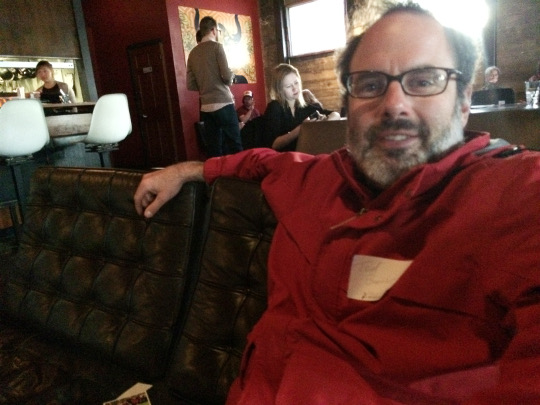
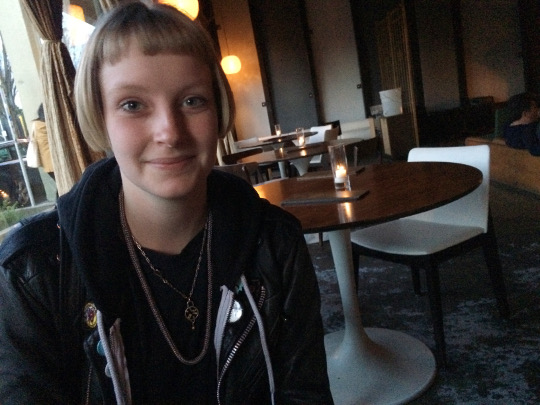
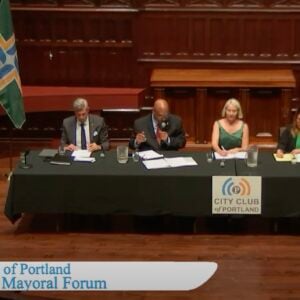

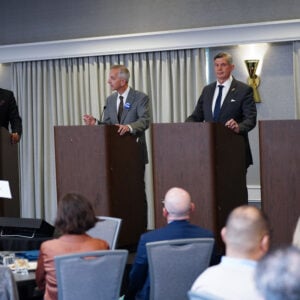

Thanks for reading.
BikePortland has served this community with independent community journalism since 2005. We rely on subscriptions from readers like you to survive. Your financial support is vital in keeping this valuable resource alive and well.
Please subscribe today to strengthen and expand our work.
Shoup!
Gesundheit!
“We asked 6 white people and 1 maybe not white person what they thought about transportation and the upcoming mayor election in Portland…”
Just stop already, stop judging everyone.
That’s a fair critique! The crowd was overwhelmingly white, but this was the crowd we chose to poll.
We don’t aim for quotas or anything like that, but one person with an East Asian name, one person with a South American name and five people with European names actually comes close-ish to Portland’s ethnic mix.
Looked like 5 white folks, one Asian, and one non-citizen Latina what they thought…
Or one might say, “we asked people who were there. We can’t help who shows up and who doesn’t.”
“Or one might say, “we asked people who were there. We can’t help who shows up and who doesn’t.””
I think we can do a lot to help who shows up.
We can target key areas and publications to publicize, we can publicize in multiple languages, we can provide child care, we can make sure our events are accessible for people with disabilities, we can make sure our events are accessible by transit, we can provide translation and sign language translation, and so on and so forth.
We can work to get key partners to co-sponsor and co-lead events, so traditionally underrepresented communities are empowered, etc.
This isn’t a critique of this event specifically, it’s just to note that much of who shows up is a reflection of how we put together events.
All very true; you find what you’re looking for. Even two of the candidates didn’t show. However, it would also seem the bigger key differentiation for a transportation-oriented event like this would not be race, but rather neighborhood-of-residence, or most-often-used transportation mode. Somebody could try to point out that “we asked 7 bicyclists, but no transit users or drivers”.
I totally agree and we should all be doing more to reach out to the groups and people we want to be involved and engaged. That being said, it can be hard to do so when you are an all volunteer run group with no real budget. Also YPT’s charge is professional development, not advocacy or activism, so our focus was really just to highlight transportation issues with candidates and bring our members’ attention to the importance of politics in our work as transportation professionals. Being that our audience was our members and friends we targeted those groups and channels to attend the event.
Now who our members and friends are is a whole other conversation that should probably be had, one that I’m personally not prepared for at the moment.
Bikes on parallel routes doesn’t work because those routes rarely have the destinations that people want to bike to. Not everyone needs to bike downtown. We need access to businesses and job centers too, almost none of which are on the bike boulevards. Eventually someone is going to have to ride on Hawthorne or 82nd, or they won’t bother making that trip by bike.
I am all for protected bike lanes downtown where there are no alternatives, but I don’t get the focus on this for locations like the eastside when there are such limited funds to spread around. The routes are PARALLEL. How does that not work if you are riding a block or two away on a PARALLEL direction and then turn onto the main drag at the intersection of your destination. As an example, I would much rather ride on Tillamook than Broadway any day. It is safer, quieter, faster, and healthier.
Even the grid in inner Portland isn’t as complete as it should be. For example, there are locations I want to visit on Powell and I can ride Clinton most of the way there, but I will eventually have to cross Powell and ride a few blocks to my destination. Another example: if the location is on the north side of Hawthorne but I am riding on Lincoln, I have to cross at a light (because it’s near impossible to cross Hawthorne otherwise) and ride the rest of the way down Hawthorne.
Additionally, I don’t always remember what block my destination is on, but I know what the building looks like, so by riding on a parallel street, I can’t just look for the building. This also discourages spontaneous shopping/dining, which is a huge benefit to biking in a business district (for riders and business owners).
Not to mention, by forcing people riding bikes off business corridors, we enforce the view by some business owners that only cars = customers.
In our world of limited funds, I would rather see, as an example, 10 miles of well constructed parallel routes, than 1 mile of well protected arterial bike lanes on the east side.
If we have such limited funds, let’s close the streets and quit spending so much on car infrastructure. There’s a parallel freeway a mile away where you can drive without worrying about any bikes or horses. We don’t need to spend any money on bikeways unless we want to have fast-moving auto traffic there.
It has to be looked at street by street, but It is rare that there are parallel routes for significant distances. To travel any distance the route becomes a convoluted patchwork. Tilamook is great, but there are not that many Tilamooks.
Many of the streets that are currently looked at as primary auto streets should be shifted toward active transportation because of increases in density and pedestrian use. Car speeds should be lowered to 20 mph, and increased crosswalks and traffic calming should be added. One of many examples is NE Fremont. It is surrounded by parks, schools and grocery stores with a ton of ped traffic, but speed limit is 30mph in many areas. If we took the approach of forcing bikes off onto alternate routes or discouraging bikes on this road and designating it an auto-centric road, it would be a detriment to the surrounding neighborhoods.
The idea of separate but equal is attractive but its a myth. If alternative routes that are equivalent to the direct routes are that great, they should rely on a natural adoption by cyclists rather than forced or pressured adoption.
SD for mayor!
Kilickitat (one block south of Fremont) is a FANTASTIC neighborhood greenway. Very efficient use of resources. I would like to seem more diverters on it to discourage cars from using it. excellent use of resources. I would much rather ride their than on Fremont.
I agree its great if you want to stay in the Beaumont / Irvington neighborhood. It breaks down several blocks east of Irving park leaving no good options to get to Williams and Mississippi. This limits its utility as a work commuting route or a leisure route of significant distance.
It may be perfect for you, but not for many other people on bikes.
The traffic on both Fremont and Knott to the North and South of Klickitat is too fast and oblivious for the degree of residential density along those streets. As car traffic increases through inner residential areas, traffic calming measures have become more about preserving safe streets rather than expanding infrastructure.
Proving people with the option of switching from a car to a bike for commutes requires bike commuting routes that are equivalent to car routes. Relegating bikes to side streets may work in some places. However, turning neighborhood collectors like Fremont and Knott into ped friendly, neighborhood friendly streets, while providing practical biking routes is better for everyone.
The sacrifices/ compromises that we make in our community to shave a few minutes off SOV driving times is absurd.
Is your complaint about the greenways that exist, or the incompleteness of the system?
There is a path, marked and traffic calmed via Siskiyou and Morris to get to Williams/Vancouver. And future paths to connect to Mississippi.
For the greenways in general, it is the incompleteness and indirectness of the system. For this route specifically, the Siskiyou and Morris route, as you know, are a block south of Klickitat and doesn’t continue to Mississppi. If I remember correctly, it is stop and go east of 20th, making it more or less a segment to go south around Irving Park to Williams/ Vancouver. I am glad that it is there and it is great work by PBOT. I think green ways are great and a good investment. Great to hear there will be an extension to Mississippi one day. However, as far as a direct route goes, it doesn’t compare to Fremont. While some cyclists would rather not ride on Fremont, I don’t believe that it is appropriate to discourage cyclists from taking a direct route if they are comfortable riding in traffic, which appeared to be suggested by some of the candidates (and definitely has been suggested by others.)
The more important issue which prompted my comment, is the speed of auto traffic on Fremont and Knott for pedestrians. Cycling and Ped conditions could be improved on both of these streets with changes to the road and speed limit. Reseting driver expectations on these roads from speedy thoroughfare to a slower route would benefit the people who live near these roads.
Couldn’t agree more that diverters would be awesome on Klickitat!
Bike infra is only as good as its weakest link. If 95% of a ride is on a fantastic greenway, but the last 5% is on a dangerous road with no infra at all, most people won’t bother making that trip at all by bike. These are the people we want to try to reach by building protected bike lanes on major corridors.
assuming that weakest link is on your route.
The concept of parallel routes depends heavily on who’s speaking. A person who hated bikes but knew they couldn’t ban them would come up with such a plan. “get those bikes out of the way of my car”.
I like the neighborhood greenway concept, but eventually you still have to ride on the main roads. I don’t personally want to give up that right. That’s exactly what you’re risking by embracing this concept.
“hated bikes”?
As opposed to someone that wanted to create a safe place for families with children, and seniors to ride? If the only system you design is one for 20-40 year olds, those are the only people you will encourage to ride.
What didn’t you understand? Surely you know some people hate that bikes are on the road right?
Re-read it. It was a pretty straightforward hypothetical. You might even find my comment about how most trips will take you to that major road you’ve been avoiding anyway.
I’m not entirely sure what businesses are on Hawthorne, 21st, 23rd, Belmont, etc because there is no safe infrastructure on those roads. Maybe if I felt comfortable riding down Hawthorne I would know which businesses were there and I would stop and spend money!
Just last night I found myself faced with this reality. I usually take the greenway and cut over to Hawthorne or Belmont at the cross street of my destination but last night I was showing someone around from out of town, we didn’t know where we wanted to go exactly so we started skating down hawthorne. Even though we were traveling 11 or 12 mph we still had cars pushing right up to us and jockeying to pass at dangerous times. I found I had to focus so intently on the cars around me that I really couldn’t pay much attention to the businesses going by. We wound up stopping at the place with the brightest sign. Protected bike lanes in business districts are definitely needed.
It caught mine too but not in a good way. The idea that main streets should prioritize motorised traffic treats people cycling like second-class road users. We need parallel AND main street bike routes if we are going to make cycling competitive with motoring. IMO, the lack of comfortable and direct main street routes is Portland’s single largest infrastructure deficiency.
Great article Michael! Thanks for covering and tweeting it so well. Also you’re welcome for asking about parking :). I too was pleasantly surprised that they all signed off on “Shoupian” parking views and that the only concern was that so many low income folks have to drive and so any parking /congestion fees should consider any further harm for them.
Will bikeportland be endorsing a candidate?
Nope.
I won’t say never, but it’s very unlikely and we’re not planning on it.
“…The proposal from several candidates — Schor, Sponberg and Ditson — that bike traffic should be carried by a “parallel network” away from main streets caught her attention. …” bikeportland
What exactly did the candidates say about a ‘parallel network’ for biking? Is that the term they used, rather than ‘protected bike lane’ system or network, or, ‘cycle track’?
Did it seem they were thinking about such a network being established along main thoroughfares in town, such as Burnside, Sandy, Hawthorne, Powell, Foster, or is it their idea to somehow use secondary or neighborhood streets paralleling certain main thoroughfares in order to provide such a network?
A system of protected bike lanes paralleling a handful of main routes between downtown and surrounding neighborhoods, could go a long way towards having practical biking be an option for people that aren’t biking now because they’re disinclined to deal with thoroughfare type motor vehicle traffic directly next to them.
It would be encouraging if at least one candidate would talk in greater detail about what the nuts and bolts of the protected bike lanes and parallel networks they bring up, actually might be in reality for Portland.
Singapore is a great example for decongestion pricing. I was deployed there in 81 and 83. Drivers paid a toll to enter the inner city way back then. Couple other things to mention about Singapore. It was illegal to spit or chew gum. Reading this blog I bet there are people in favor of all that totalitarian garbage.
There are smart ways to travel on a bicycle. I don’t want to bike on the busiest streets. Parallel routes are better IMO. People live in a fantasy that cars are going away, they are not. The trick is to avoid as much traffic as possible. But you fantasy cyclists want to ride every where, even places you are endangered and miserable. Sheer folly to make a absurd point.
“People live in a fantasy that cars are going away, they are not.”
Really? Care to elaborate your feelings about this? Support this contention?
I could just as easily and with perhaps the same conviction assert that:
“People live in a fantasy that cars are not going away, they are.”
But without some argument neither of these statements mean a whole lot.
When about 90% of metro area travelers are regularly traveling by car as they are now, the burden would be on those convinced that cars are going away to prove their point, not the other way.
(1) current mode share in this town has very little to do with future prospects of automobile mode share. Although we have, of course, gotten used to this arrangement where the car is typically quicker, easier, or necessary due to a thousand small and not so small tweaks to our system that favor the car, this does not in and of itself help us understand the future viability of this mode.
(2) You might even agree that if the (cheap) petroleum spigot were turned off, the whole system would grind to a halt, never mind that a large fraction (though probably not 90%) habitually get in a car. But there are several other possible reasons this system could very quickly become untenable, the exigencies of climate change being only the most obvious.
I am under no illusion that many institutions and many of us will fight to the death to keep the auto thing going, but that won’t likely be enough. We here in the US are used to getting our way, throwing money or weapons at anything that is perceived to interfere with our consumption patterns, but the time may come when we can no longer throw our weight around like that and get the results we’ve grown accustomed to.
Electric cars will replace gas cars long before the system ever has a chance to come grinding to a halt.
A familiar retort, and in my view utterly fanciful.
Electricity is not a fuel.
We don’t have excess capacity.
A tiny fraction of our grid is renewable.
If we were to try to do this, and there are many who want to believe it is possible, the capital required boggles the mind.
http://climatenewsnetwork.net/renewable-energy-demands-undoable/
Natural gas will be utilized more to generate electricity.
Which is so abundant and has not climate impact.
Let’s imagine that fracking plays out in, oh, 36 months. Then what?
capturing and burning waste and biomass-associated methane is a no brainer from a climate change mitigation perspective. it’s utterly pathetic that portland does not do this.
Decongestion pricing is an interesting idea. Parts of London have it, isn’t that right? If people need to get somewhere, and the only practical way available for them to do that is by car, they’re going to go by car, regardless of whether it involves a toll to do it. Whether decongestion pricing can work, and work well, depends on a bunch of factors. For Portland too.
Infrastructure for biking could be a lot of better, if it’s for practical biking that this infrastructure is conceived and designed for. Meetings and presentations I’ve gone to in past, during which I talked briefly with some officials and planners, here in Beaverton, were discouraging.
The officials and planners were happy to comply with various specs and requirements needed to have their projects approved by higher level government agencies holding the funding….but a broad view of bicycling’s potential for being a key component of the city’s travel system, seemed seemed to be absent among them. They do recognize the appeal of biking for recreational and city livability enhancement…they want the city to be an enjoyable place to be in, and being able to bike some is part of that, but for practical purposes…I didn’t get the impression they would consider the creation of a protected bike lane system, even a very basic one, to be essential for the city’s future.
Same impression I get, reading about the various people running for mayor of Portland. When interviewing, and talking to people that may be persuaded to vote for them, it’s compelling for them to mention biking, protected bike lanes, and whatnot, but in terms of their words answering the question of whether, under their leading of the city, that type infrastructure would be expanded as part of an essential aid to meeting city residents’ travel needs, and resolving some of the city’s traffic congestion…the candidates come up lacking.
People live in a fantasy world that cars will continue to be the best way to move around a growing city, but they will not.
We already have a “parallel network” in most of Portland. It’s called bike boulevards or neighborhood greenways, and it’s clearly beginning to show its limits. Much like the BRT concept, it’s easy to dilute it down to it most basic and least beneficial iteration; you can call something a bike boulevard just by painting a sharrows every couple blocks.
I feel like all of the candidates are still reactive to transportation issues. Who is willing to make and stand behind a bold proposal, something that actually sounds inspiring and would yield such broad benefits that the conversation wouldn’t immediately be drowned out in the technical details?
How about something big, like “a sidewalk on every street, and a protected bike lane on every major street” for a start?
Diverters are very cheap and effective. If City Council prioritized bike infra more, there’s really no reason why we can’t simultaneously build protected bike lanes on arterials and drop diverters all over inner neighborhoods.
Diverters are cheap and effective; but the political circus required to build each single diverter is ridiculous, considering the bike boulevards are basically supposed to be residential streets that don’t promote vehicle through-traffic in the first place.
It’s time to find a political leader who will commit to something bigger than having PBOT react to advocates and neighborhood associations each time a hyper-local issue boils over into citywide news.
I’m not against diverters; but if we’re deciding that diverters are going to be the major driver of neighborhood bikeability in some sort of “parallel network”, then our leaders need to be demanding something more radical and interesting to the wider public, like “a diverter every five blocks, on every residential through-street in the city”.
Totally agree, and this is where our focus on corridors fails. We need to be moving to a neighborhood-wide scope for diversion.